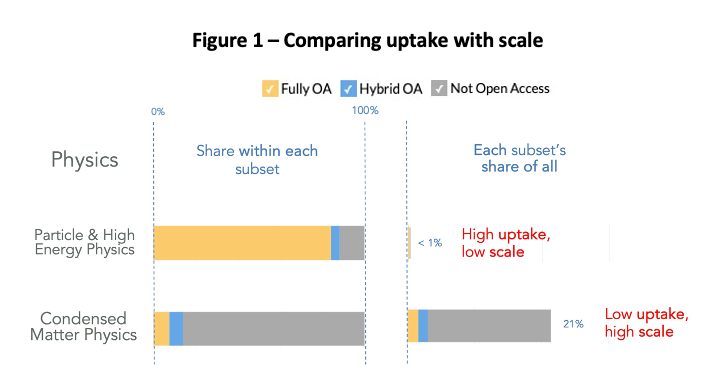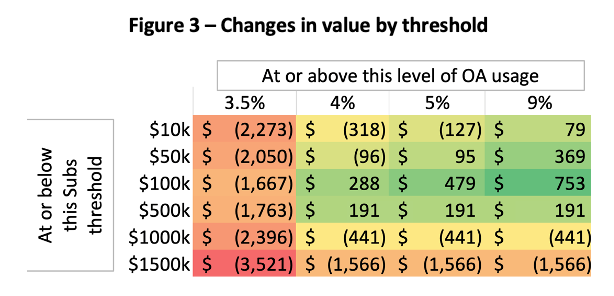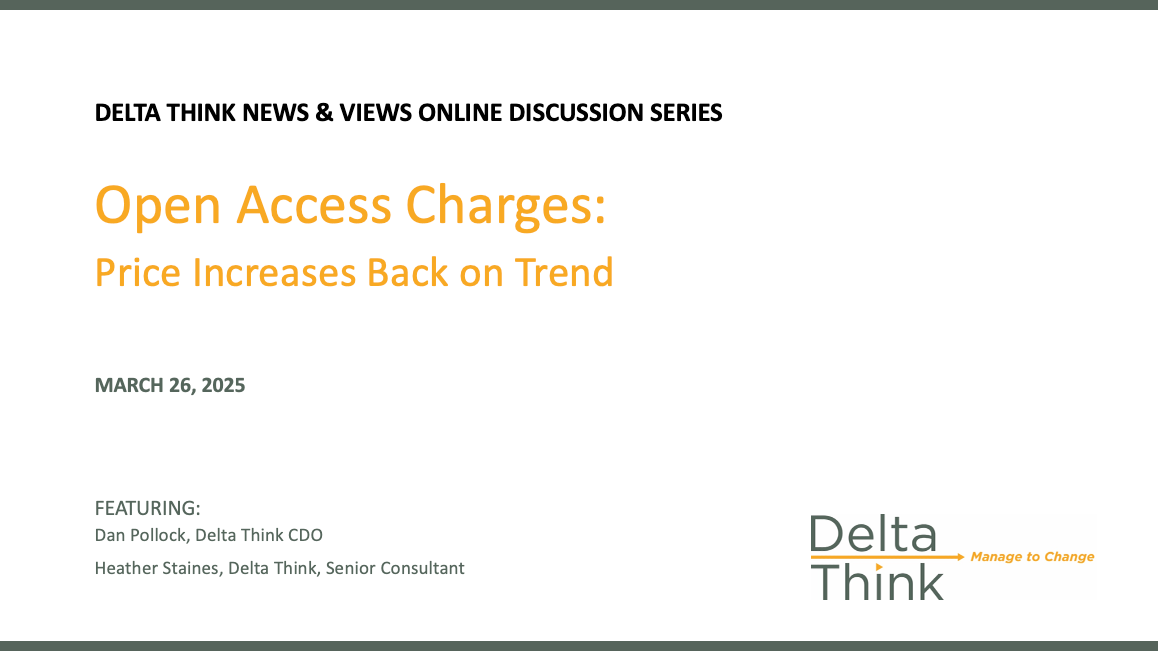News & Views: What questions should your organization ask during times of change?

At Delta Think, we’re big fans of using data-driven decision making to help you navigate our changing world. But how do you determine what data you need and what decisions you need to take?
This month, we change our usual approach and look at some questions that you can ask to help find your way in a time of constant change, as well as the data you might need to answer them.
Background
The world of scholarly publishing continues to evolve.
- Generative AI is currently trending, but new technology is nothing new. Remember the Information Superhighway? Web 2.0? The iPad revolutionizing the way we consumed content? The rise of XML?
- Last summer’s OSTP memo made headlines. A zero embargo on open content is a significant and potentially disruptive change. But new policies have continued to shift: Plan S, the NIH deposit mandate, China’s publishing evolution, the Wellcome Trust’s early OA policies, to name a few.
- Open Access was once an unproven model that many considered unlikely to be financially viable. Born-OA publishers now account for one fifth of content produced and have been growing an order of magnitude faster than the underlying market.
- The APC-based OA business model is now itself being disrupted. Big OA publishers’ growth is slowing. Transformative Agreements and their like might move OA closer to the Big Deal. New Subscribe to Open launches are increasing even as calls for more equity are making publishers rethink their APC models entirely.
- Operations change too. Publishers that once outsourced and divested their production suppliers have been acquiring publishing platforms and services companies as part of their competitive strategy.
Change brings with it questions.
So what? How does my organization adapt? Should we do things differently? If so, how? And when? What should we do next?
Questions
To get a handle on these big questions, we suggest breaking them down into smaller parts to work through how to set strategies and plan for change. It might also help to consider the answers to your questions using two different lenses:
- Focus – where should you prioritize your efforts?
- Risk – what could go wrong or right?
In the following sections, it is not our intent to cover every question you might ask. Our goal instead is to surface a few questions and demonstrate how you might go about answering them.
1. Focus
Even small specialist publishers with a few journals will likely cover several disciplines. Mid and large-sized publishers will cover many more. We frequently write about how a specific publisher’s situation will determine whether an industry trend has greater or lesser effects. When dealing with change, it’s vital to understand how different journals or collections of journals might be affected.
For example, if considering the effects of a policy that promotes “open” publishing, you might ask:
- What is the appetite “out there” for open vs closed content?
- How does this compare with what we publish?
- How does this vary by journal? By collection? By discipline?
- What are the big and small areas of content usage?
- How are they changing over time?
The figure below works an example for two subjects within physics. It’s deliberately simple to illustrate the principle of building simpler questions into broader insights.

Source: Delta Think analysis. © 2023, Delta Think Inc., all rights reserved.
The figure above looks at our estimates of articles published in the addressable market (research publications for which money is likely to be paid, either to read or to publish).
- The left side of Figure 1 shows uptake of different access types. Particle & High Energy Physics (HEP) has high uptake of OA: almost 90% of its content is published OA, with over 90% of that published in fully open (gold) journals. Compare this with Condensed Matter Physics, with just under 15% of output published OA, split roughly equally between fully open and hybrid journals.
- A publisher with journals covering these areas might therefore prioritize HEP if considering launching a new journal to meet growing demand for OA. A library might consider negotiating lower subs prices or cancelling subscriptions for HEP journals.
- However, looking at the right side of the chart, HEP covers just 1% of output in physics. So that new journal may have little effect on the publisher’s fortunes, and that cancellation little effect on the library’s spending. Condensed Matter accounts for over a fifth of physics output. If you multiply the ratios, a new Condensed Matter Physics journal would have over 3x the effect of an HEP one in this context. It might, therefore, be better to focus on Condensed Matter.
Our example here is simple, but the principle scales well. We have run projects that cover dozens of subject areas, using charts like these to highlight where a publisher’s leadership team should focus their priorities.

Source: Delta Think analysis. © 2023, Delta Think Inc., all rights reserved.
Figure 2 shows thumbnail sketches of how the Uptake vs Scale comparison looks across 200+ subjects. As before, they compare uptake (left, share of output within subjects) with scale (right, contribution to total for each subject).
- You are not meant to see the detail at this resolution. In fact, the point is to show that in the real world, the situation is complicated.
- In practice, we often present analyses like these as an interactive spreadsheet, which highlights the key outliers and allows clients to navigate the chart to zoom into the details as needed.
- We also develop scoring systems to combine the different dimensions (uptake and scale) into easy-to-digest metrics.
2. Risk
Any change has the potential to disrupt the status quo. Another key set of questions therefore falls under the “what might break” category. If a particular policy was enacted or adopted, how might the revenue or cost change? Developing our example of looking at a policy promoting “open” publishing, you might ask:
- What subscriptions might be at most or least risk?
- Are there multiplier effects? For example, bundles or collections of journals that might be much less attractive if just a few key journals were removed or made open.
- Are we clear about the value of subscriptions and of OA activity… by journal/collection/subject?
- Are there other sources of value, such as advertising or licensing? How much are they dependent on paywalls or publishing fees?
- At what threshold might we need to flip a journal from hybrid OA to fully OA?
- At what threshold does a subscription journal become unviable?
- How do we measure thresholds: Pricing? Volumes of output? Usage?
You usually need to combine focus (such as uptake and scale, as above) with financial modelling to address these questions. For example, if a journal’s subscriptions collapsed because of a move to open, it may have little effect on publisher income or library spend if the subs value is very small. Visualizations therefore need to work in three dimensions to help you gain insight.

Source: Delta Think analysis. © 2023, Delta Think Inc., all rights reserved.
Figure 3 illustrates the idea of turning questions into data. Here we’re looking at gains vs. losses in value across a specific group of journals. (This is a simplified table pulled from real world examples, but the data is illustrative.)
- By comparing different values of subscriptions (rows), with different levels of OA uptake or usage (columns), we can see where the sweet spot lies for moving a journal or collection to OA vs. not (or continuing a subscription or not – the model works for buyers too).
- Here, for low volumes of current OA use, the publisher would be worse off if it moved to OA (negative numbers in brackets on the left column of the table). But, as OA uptake increases (moving to the right of the table), the OA fees start to offset the loss in subs (green, positive numbers middle right). However, this is only true if the subscription revenue wasn’t too large to begin with (yellow & orange negative numbers in the bottom rows). In this case, there is more ground to make up when moving to OA. The same principle applies when assessing library subscriptions.
- The subtlety behind visualizations such as this is to choose the correct data, based on the questions being asked. For example, if considering the effects on subscriptions, you would need to decide whether to analyze things such as revenue, collection coverage, or usage.
Conclusion
“Forty-two," said Deep Thought, with infinite majesty and calm. It was a long time before anyone spoke. “I think the problem … is that you've never actually known what the question is.”
The challenge is that the big open-ended changes we encounter lead to big, open-ended questions. By breaking them down through a process of analysis, we can arrive at the right questions, which in turn leads us to the right decision-making tools.
The starting point is often a variant on “Will I be better or worse off,” which can then be expanded into the specific details. “How much does x make or cost?” “What’s the appetite for this over that?” “What contributes to its success or failure” “What will make a noticeable difference?” “How do I balance growth and scale?”
We have floated some questions here. Please do get in touch and let us know your thoughts. What questions is your organization facing? What should we be asking?
This article is © 2023 Delta Think, Inc. It is published under a Creative Commons Attribution-NonCommercial 4.0 International License. Please do get in touch if you want to use it in other contexts – we’re usually pretty accommodating.













